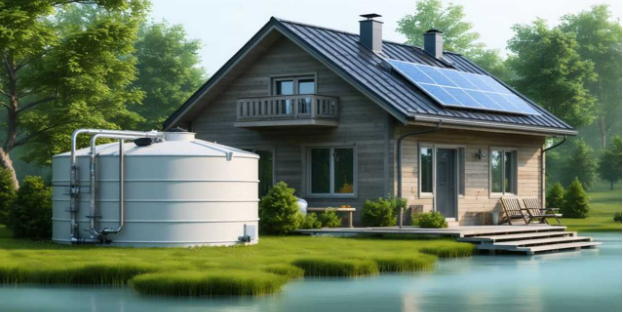
Welcome to the Off-Grid Blueprint 2025your complete guide on how to live off the grid. This is a practical guide for anyone ready to step outside the traditional system and adopt a self-sufficient lifestyle.
The constant climate-related disruptions and the rise of energy costs a lot of people are rethinking about their well-being. The goal is to live efficiently and cut costs.
And in 2025 going off the grid isn’t reserved for selective people. This is a lifestyle shift which is attracting eco-conscious families, digital nomads and the individuals seeking to join this movement.
This step-by-step going off the grid guide will walk you through everything. From choosing your ideal lifestyle path to setting up sustainable systems and avoiding common mistakes.
The goal here is to help you build a thriving and independent life without relying on unstable infrastructure and unsustainable norms.
You could envision what it's like to live in this modern off-grid mode but don’t really know it all in a practical sense. This is what this guide provides.
Let’s dive in.
2025 is attracting off-grid living due to the various issues going on related to environmental shifts and economic disparities.
In the span of 2020 and 2024, U.S. electricity costs rose over 20% in many states. In states like California and Texas blackouts and grid instability have become more frequent making off-grid energy independence a choice to consider.
The climate is changing rapidly for the worse resulting in wildfires, hurricanes, water shortages and floods. Self-sufficient lifestyles are on a surge because they gives you control over resources like power, water and food.
Have you heard of the “great disconnection”? People are now tired of the hustle and bustle of the city and turning towards living off-grid and connect with nature. Google searches for “how to live off the grid” have increased by over 65% globally in the past two years especially among millennials and Gen Z.
Buying a traditional house is too expensive and is a big responsibility that’s why tiny houses, off-grid land plots and modular cabins are now piquing the interests of many. It’s an affordable alternative.
Off-grid trends in 2025 are here to stay and it's not limited to certain clicks but to those who want a practical choice. Now is the right time to educate yourself and switch if you want to.
There are various modes of how to live off the grid. Let’s take a look-
Best For: Solo travelers, digital nomads
Pros: Flexibility, low initial cost, mobile freedom
Cons: Limited space, water/waste challenges, road dependency
Van life became popular during the pandemic times and still remains strong in 2025. It is equipped with solar panels and composting toilets making mobile living easier.
Best For: Families, couples, long-term stability seekers
Pros: Full control over land and food-growing potential
Cons: Higher upfront investment and requires more maintenance
It’s a quiet off-grid living in the countryside with solar panels and gardening. Using as many natural resources as possible for daily use.
Best For: Community-minded individuals, shared resource users
Pros: Built-in social support, shared workload
Cons: Less autonomy, governance issues
In places like the U.S., Europe, and parts of Asia, people are starting to form off-grid communities. They share things like solar power and living spaces and work together.
Best For: Remote workers, freelancers and global citizens
Pros: Income sustainability, flexible setups
Cons: Reliant on internet access
This setup is basically living off-grid but with modern tech. Solar setups, mobile workspace and remote income streams are all included.
.png)

You cannot transition off the grid overnight. This step-by-step off-grid transition plan explains exactly how to make it happen.
Going off the grid begins with a mindset.
This detox isn’t about deprivation. It’s about empowerment.
A smart budget to go off grid can mean the difference between freedom and stress.
How to go off the grid legally varies widely by region.
Build your setup around key infrastructure pillars:
Even if you want solitude. Connection is always the key.
.png)
Your setup is only as strong as your tools. Today’s smart off-grid tools make life easier, safer, and more comfortable.
These sustainable energy gadgets and communication tools bridge the gap between off-grid living and modern comfort.
Let’s get real about off-grid costs in 2025. The price varies based on lifestyle, DIY efforts, and location.
You can definitely build off grid on a budget, especially with repurposed materials and phased upgrades.
No matter your gear, skills for off-grid living are the true foundation.
Off-grid training programs and YouTube communities can help you get there you need no university.

Off-grid success isn’t about being isolated. It’s about being prepared and connected.
A safety net turns temporary failure into growth. That’s the secret to safe off grid living.
Even the best plans hit bumps. Here are some of the most common off grid mistakes to avoid.
Avoid these beginner off-grid errors, and you’ll save money, time, and stress.
Can I go off the grid with no money in 2025?
It’s hard, but possible. Look for off-grid internships, lease-to-own land, and barter-based communities. Creative income sources help.
Is it legal to disconnect completely?
In many places, yes—but always check off-grid laws. Some states mandate water or power connections.
What are the most affordable states/countries?
U.S.: Arizona, Missouri, Arkansas.
Global: Portugal, Ecuador, parts of India. Each offers low-cost land and minimal regulation.
How much land do I need?
1–5 acres is enough for most homesteads. Van life needs none, just a parking strategy.
What are good tips for off-grid on a budget?
DIY as much as possible, buy used gear, build incrementally, and join online off-grid groups for shared resources.
For more answers, check out our complete off-grid faq 2025 archive.
Ready to take the leap?
Here’s your final off-grid checklist:
✅ Choose your lifestyle path
✅ Begin digital + financial downsizing
✅ Research legal zones & land
✅ Invest in core systems (energy, water, food)
✅ Build emergency and social backups
✅ Master essential survival skills
.png)
The road to off-grid living in 2025 is no longer paved with uncertainty. With the right mindset, legal knowledge, tech tools, and skills, you can absolutely build a life of independence and intention.
And when you're ready to plan your solar-powered setup, don’t just guess. Use ARKA 360’s solar design and proposal software to simulate system size, storage needs, and ROI, all in one intuitive platform.
Off-grid doesn’t mean off-mission. Let 2025 be your blueprint for a stronger, simpler future.













